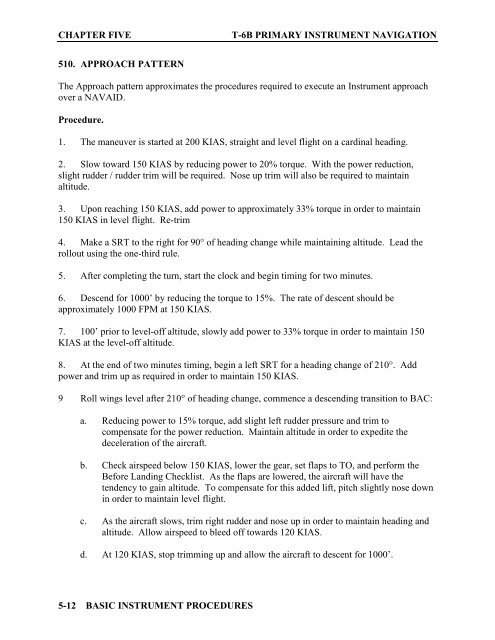Flight Training Instruction - Cnatra - U.S. Navy
Flight Training Instruction - Cnatra - U.S. Navy
Flight Training Instruction - Cnatra - U.S. Navy
Create successful ePaper yourself
Turn your PDF publications into a flip-book with our unique Google optimized e-Paper software.
CHAPTER FIVE T-6B PRIMARY INSTRUMENT NAVIGATION<br />
510. APPROACH PATTERN<br />
The Approach pattern approximates the procedures required to execute an Instrument approach<br />
over a NAVAID.<br />
Procedure.<br />
1. The maneuver is started at 200 KIAS, straight and level flight on a cardinal heading.<br />
2. Slow toward 150 KIAS by reducing power to 20% torque. With the power reduction,<br />
slight rudder / rudder trim will be required. Nose up trim will also be required to maintain<br />
altitude.<br />
3. Upon reaching 150 KIAS, add power to approximately 33% torque in order to maintain<br />
150 KIAS in level flight. Re-trim<br />
4. Make a SRT to the right for 90° of heading change while maintaining altitude. Lead the<br />
rollout using the one-third rule.<br />
5. After completing the turn, start the clock and begin timing for two minutes.<br />
6. Descend for 1000’ by reducing the torque to 15%. The rate of descent should be<br />
approximately 1000 FPM at 150 KIAS.<br />
7. 100’ prior to level-off altitude, slowly add power to 33% torque in order to maintain 150<br />
KIAS at the level-off altitude.<br />
8. At the end of two minutes timing, begin a left SRT for a heading change of 210°. Add<br />
power and trim up as required in order to maintain 150 KIAS.<br />
9 Roll wings level after 210° of heading change, commence a descending transition to BAC:<br />
a. Reducing power to 15% torque, add slight left rudder pressure and trim to<br />
compensate for the power reduction. Maintain altitude in order to expedite the<br />
deceleration of the aircraft.<br />
b. Check airspeed below 150 KIAS, lower the gear, set flaps to TO, and perform the<br />
Before Landing Checklist. As the flaps are lowered, the aircraft will have the<br />
tendency to gain altitude. To compensate for this added lift, pitch slightly nose down<br />
in order to maintain level flight.<br />
c. As the aircraft slows, trim right rudder and nose up in order to maintain heading and<br />
altitude. Allow airspeed to bleed off towards 120 KIAS.<br />
d. At 120 KIAS, stop trimming up and allow the aircraft to descent for 1000’.<br />
5-12 BASIC INSTRUMENT PROCEDURES
















